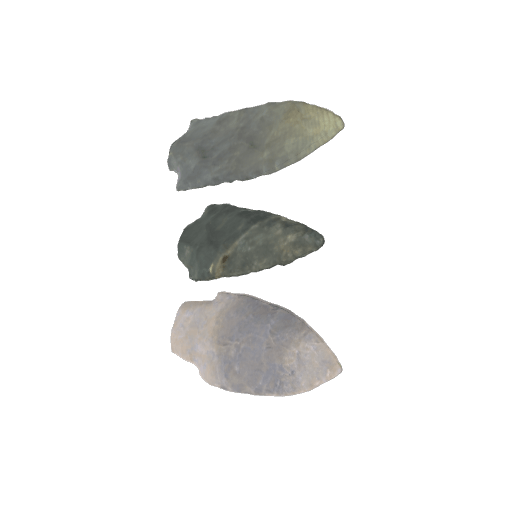Projectile points
These projectile points are made of stone. Depending on their shape, they can be attached on a long wooden pole to become harpoons, spears, arrows, etc. The different types of points are distinctive of an archaeological period and a cultural group.
Projectile points are generally made of chert stone, quartzite, or schist stone, using a method called percussion flaking: the stone is broken off, or knapped, flake by flake, to produce a sharp point. First, a hard stone, called a hammerstone, is used to remove larger flakes of the stone, then a soft hammer, such as an antler, is used for more precise shaping.
Two chert quarries are located on the shores of Lake Touladi in the Témiscouata region. They have been exploited for several millennia by Indigenous peoples, as evidenced by the many stone flakes and lithic tools found on site. To extract the material, stones are first collected from outcrops and sometimes rough-cut on the site. They are then brought to the work site or settlement to be knapped, and finally used for their intended purpose.
In archaeological sites, only the points and flakes from the knapping process remain, since the wooden shafts are perishable. By determining the stone’s place of origin, it becomes clear just how significant the trade network was between Indigenous peoples, who transported artifacts across the North American territory.
As complex as their trading network is, so too are their political and territorial systems. Weapons fitted with projectile points are used in wars between Indigenous peoples. Conflicts may be motivated by economic or political reasons, such as access to a specific resource or control of a trade route. The conflicts can also be rooted in cultural beliefs. For instance, among the Iroquoians, war is often waged to capture prisoners to replace a dead person. The captives are then handed over to bereaved families as a replacement for the deceased.
References
Date: Before the 16th century
Origin: Témiscouata
Owner: Parc national du Lac-Témiscouata. Saint-Michel-du-Squatec.
Sources:
Pintal, J.-Y. (n.d.). Les pointes de projectile, une remarquable diversité [Projectile points, a remarkable diversity]. ARCHÉOLAB.QUÉBEC. Retrieved September, 2022, from https://www.archeolab.quebec/familles-d-objets/pointes-de-projectiles
Desrosiers, P. M. (n.d.). Les pointes en pierre du Nunavik [Nunavik’s stone points]. ARCHÉOLAB.QUÉBEC. Retrieved September, 2022, from https://www.archeolab.quebec/familles-d-objets/pointes-de-projectiles
